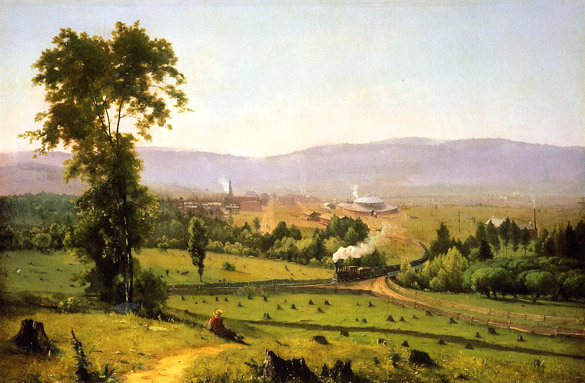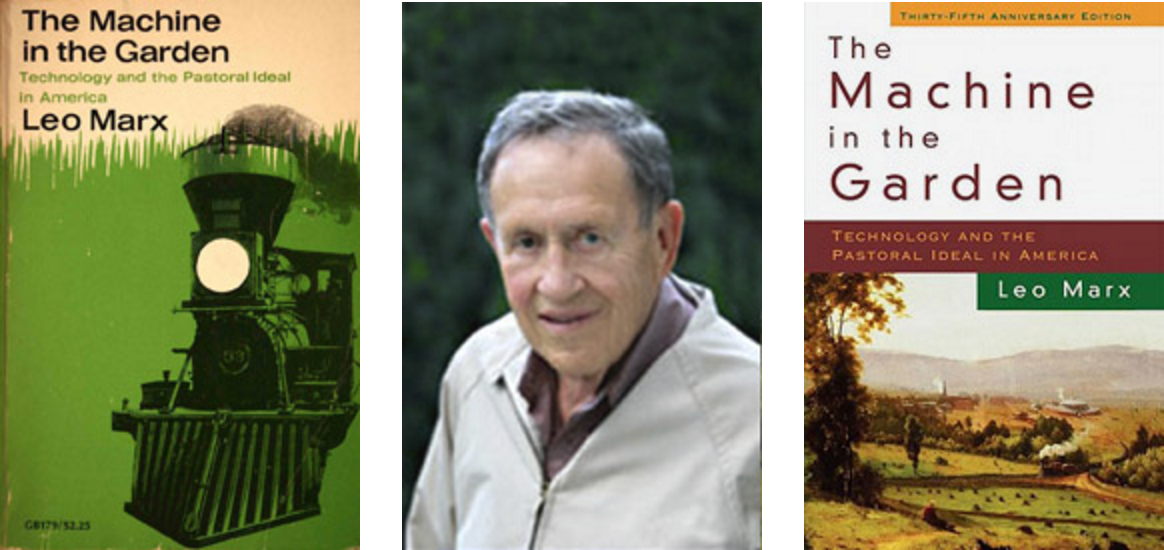Symposium honors 50th anniversary of The Machine in the Garden
enduringly influential work by Leo Marx, MIT Professor Emeritus

Painting: George Inness, The Lackawanna Valley, 1855
For over four decades, Leo Marx's work has focused on the relationship between technology and culture in 19th- and 20th-century America. His research helped to define the area of American studies concerned with the links between scientific and technological advances, and the way society and culture determine these links.
MIT PROFESSOR EMERITUS LEO MARX wrote The Machine in the Garden: Technology and the Pastoral Ideal in America in 1964, before cell phones, the Internet, and computers became omnipresent in American life. Yet today this work — centered on the tensions nineteenth century authors saw as shaping American life — remains as relevant as ever.
On November 8, 2013, colleagues and former students gathered to celebrate the 50th anniversary of Marx’s book with an afternoon symposium at MIT. Speakers recounted the legacy of this seminal work in American studies as well as of the teacher and scholar who penned it.
The pastoral and progressive visions
“The book is about the ambivalences in the encroaching of science and technology in everyday life. Marx was writing about railroads and telegraphy, but the notion is that technology allows great things — it knit the nation together — but it also seemed to tear down what had been safe spaces of the pastoral,” said David Kaiser, the Germeshausen professor of the history of science, speaking in advance of the event.
“The power of Marx’s analysis and prose makes it still worth reading today,” added Kaiser, who is also head of MIT’s Program in Science, Technology, and Society (STS), which hosted the symposium along with the Marx family and Oxford University Press.
Coinciding with the 25th anniversary of MIT’s PhD program in History, Anthropology, and Science, Technology and Society — which was marked on November 9 with a daylong symposium at MIT — the Machine in the Garden event drew over 200 people to Wong Auditorium to reflect on the influence Marx has had both on the field, and on the lives of his students and colleagues.

“Machine in the Garden has consistently been a book people thought was important to read, one that makes sense of our relationship to history and technology. The book has gone through dozens of printings and sold hundreds of thousands of copies — an impressive figure by any measure.”
— Niko Pfund, President, Oxford University Press, USA
Daring, enduring, persuasive
After an introduction by Kaiser and a few words by Marx’s son Andrew, the event featured reflections by five key associates, beginning with a representative of the book’s publisher, Oxford University Press.
Emphasizing that it is “really a remarkable accomplishment” for any book to remain in print continuously for 50 years, Niko Pfund, president and academic publisher of Oxford University Press, USA, reminded everyone of what else was going on the year The Machine in the Garden was first published: Barry Goldwater was running for president; Nelson Mandela was sentenced to life in prison; and Elizabeth Taylor had just married Richard Burton (for the first time).
“Through it all, Machine in the Garden has consistently been a book people thought was important to read, one that makes sense of our relationship to history and technology,” Pfund said. “The book has gone through dozens of printings and sold hundreds of thousands of copies — an impressive figure by any measure.”
Alan Trachtenberg, a former graduate student of Marx’s who is now a professor emeritus of English and American studies at Yale University, stressed the book’s antecedents in the Cold War. He said The Machine in the Garden reveals rich crosscurrents among literary, economic, and political issues, reflecting both Marx’s experience as a veteran of World War II and his socialist politics.
“What moved me most of all as an aspiring American studies scholar — and has remained a major bequest of the book — was and still is the book’s daring and movingly persuasive historicism,” Trachtenberg said. “Fifty years later, The Machine in the Garden remains a work to live up to.”
3 Questions
Interview about The Machine in the Garden
with Rosalind Williams, Bern Dibner Professor of Science and Technology

L to R: The Berkshire Hills, George Inness; Professor Rosalind Williams; The Buffalo Trail, Alfred Bierstadt
A legendary teacher
David Nye, professor of American History at the University of Southern Denmark, emphasized that Marx was not only a great writer but a wonderful teacher. Nye studied with Marx as an undergraduate at Amherst College, where Marx taught before coming to MIT in the 1970s to help launch STS.
“One reason the book was so accessible is that it had been taught before it was written; it had been honed over time,” Nye said. “There’s an unfortunate pressure now to rush things into print. The link between teaching and research was clear here.”
Rebecca Herzig also lauded Marx’s teaching. A PhD graduate of the MIT SHASS Program in History/Anthropology/Science, Technology and Society (HASTS) and a former advisee of Marx’s, Herzig is now a Professor of Women and Gender Studies at Bates College. “I am and always will be Leo’s devoted student, striving to be half the teacher and half the mensch he is,” she said.
To conclude, Rosalind Williams, Bern Dibner Professor of the History of Science and Technology, offered her recollections of teaching classes at MIT with Marx. What impressed her the most, she said, was his relentless dedication to the task. No syllabus ever seemed to be complete; Marx was always honing his approach to teaching great literature. And, Williams noted insightfully, “He is never teaching his book. He’s teaching the books in his book, classics like Walden and Moby Dick.”
The afternoon’s formal remarks were followed by a lively comments period, which enabled Marx’s many admirers to offer their own recollections of the man and his work. Through it all, the guest of honor himself sat quietly in the front row. Afterward, Marx quietly called the event “most unusual and terribly moving.”
Suggested Links
The Machine in the Garden | Oxford University Press
Pastoral genre in literature
Program in Science, Technology, and Society
About the book
For over four decades, Leo Marx's work has focused on the relationship between technology and culture in 19th- and 20th-century America. His research helped to define the area of American studies concerned with the links between scientific and technological advances, and the way society and culture both determine these links. The Machine in the Garden fully examines the difference between the "pastoral" and "progressive" ideals which characterized early 19th-century American culture, and which ultimately evolved into the basis for current environmental debates. — Oxford University Press
About Leo Marx
MIT Kenan Sahin Professor of American Cultural History, Emeritus
Leo Marx received his B.A. (History and Literature, 1941) and his Ph.D. (History of American Civilization, 1950) from Harvard University. He taught at the University of Minnesota and Amherst College before coming to MIT in 1976. Professor Marx has three times been a Fulbright Lecturer in Europe, twice a Guggenheim Fellow, and a Rockefeller Fellow. He is a fellow of the American Academy of Arts and Sciences, and has been president of the American Studies Association, and chair of the American Literature Section of the Modern Language Association. His work examines the relationship between technology and culture in 19th and 20th century America. He is the author of The Machine in the Garden: Technology and the Pastoral Ideal in America (1964);The Pilot and the Passenger: Essays on Literature, Technology, and Culture in America (1988); editor (with Merritt Roe Smith), Does Technology Drive History?: The Dilemma of Technological Determinism (1994); and editor (with Bruce Mazlish), Progress: Fact or Illusion? (1996).
Story prepared by MIT SHASS Communications
Editorial and Design Director: Emily Hiestand
Senior Writer: Kathryn O’Neill
Communications Assistant: Kierstin Wesolowski
Painting, top; George Inness, The Lackawanna Valley, 1855